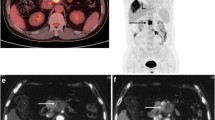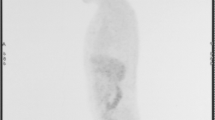Abstract
FDG-PET has proven to be a valuable diagnostic tool in patients with a carcinoma of unknown primary. In patients presenting with cervical metastases of unknown primary, FDG-PET makes it possible to locate a primary in 36% of the patients and induces therapeutic modification in 39%. This examination should be carried out prior to upper endoscopy, guiding the biopsies when possible. In patients presenting with non-cervical metastases, FDG-PET localize the primary in 37% of cases, with an impact on the therapeutic management in 42% of the patients. Recent results from coupled PETCT-scanning examinations seem to improve the diagnostic performances this assessment modality, especially its specificity. The prognostic value of FDG-PET still needs to be evaluated.
Résumé
La TEP-FDG présente de façon indiscutable un intérêt dans la prise en charge des patients présentant un syndrome CAPI. Pour les CAPI avec métastases cervicales, la TEP-FDG permet de localiser le primitif pour 36 % des patients et entraîne une modification thérapeutique dans 39 % des cas. La TEP-FDG devrait être réaliseé avant la pan-endoscopie. Cela permet de diriger les biopsies. Par ailleurs, la réalisation de la TEP-FDG après la pan-endoscopie augmente fortement le risque de faux positif. Pour les patients qui présentent des métastases autres que cervicales, la TEP-FDG permet de localiser le primitif en moyenne dans 37 % des cas, de localiser la présence d’une extension métastatique plus importante chez 42 % des patients et induit une modification thérapeutique pour 35 % des patients. Dans cette indication, la TEP-FDG semble plus intéressante dans les formes localise és que multifocales où l’identification d’un primitif est plus délicate et l’impact thérapeutique moins important. L’apparition récente des études couplées TEPCT semble améliorer discrètement la sensibilit’ede cet examen et surtout en améliorer significativement la spécificité. Enfin, l’intérêt pronostique de la TEP-FDG dans cette catégorie de patients reste à être précisé.
Similar content being viewed by others
Références
Aassar OS, Fischbein NJ, Caputo GR, et al. (1999) Metastatic head and neck cancer: role and usefulness of FDG PET in locating occult primary tumors. Radiology 210: 177–181
Alberini JL, Belhocine T, Hustinx R, et al. (2003) Whole-body positron emission tomography using fluorodeoxyglucose in patients with metastases of unknown primary tumors (CUP syndrome). Nucl Med Commun 24: 1081–1086
Bohuslavizki KH, Klutmann S, Kröger S, et al. (2000) FDG-PET detection of unknown primary tumors. J Nucl Med 41: 816–822
Braams JW, Pruim J, Kole AC, et al. (1997) Detection of unknown primary head and neck tumors by positron emission tomography. Int J Oral Maxillofac Surg 26: 112–115
Chorost MI, Lee MC, Yeoh CB, et al. (2004) Unknown primary. J Surg Oncol 87: 191–203
Fencl P, Belohlavek O, Skopalova M, et al. (2007) Prognostic and diagnostic accuracy of (18F)FDG-PET/CT in 190 patients with carcinoma of unknown primary. Eur J Nucl Med Mol Imaging 34: 1783–1792
Freudenberg L, Fisher M, Antoch G, et al. (2005) Dual modality of 18F-fluorodeoxyglucose-positron emission tomography/computed tomography in patients with cervical carcinoma of unknown primary. Med Princ Pract 14: 155–160
Garin E, Devillers A, Prigent F, et al. (2003) Acquisitions simultanées TEP/scanner: apport chez les patients suspect de reécidive de cancer colorectal. Med Nucl « imagerie fonctionnelle et métabolique » 12: 665–675
Garin E, Prigent-lejeune F, Lesimple T, et al. (2007) Impact of FDG-PET in the diagnosis and therapeutic care of patients presenting with metastases of unknown primary. Cancer Invest 25: 232–239
Greven KM, Keyes JW, William TJ, et al. (1999) Occult primary tumors of the head and neck. Lack of benefit from positron emission tomography imaging with 2-(18F)fluoro-2-deoxy-D-glucose. Cancer 86: 114–118
Gupta NC, Nicholson P, Bloomfield SM (1999) FDG-PET in the staging work-up of patients with suspected intracranial metastatic tumors. Ann Surg 230: 202–206
Gutzeit A, Antoch G, Kuühl H, et al. (2005) Unknown primary tumors: detection with dual modality PET/CT-initial experience. Radiology 234: 227–234
Hanasono MM, Kunda LD, Segall GM, et al. (1999) Uses and limitations of FDG-PET in patients with head and neck cancer. Laryngoscope 109: 880–885
Hatanaka M (1974) Transport of sugar in tumor cell membranes. Biochim Biophys Acta 355: 77–104
Heller MT, Meltzer CC, Fukui MB, et al. (2000) Superphysiologic FDG uptake in the non-paralyzed vocal cord: resolution of a false positive PET result with combined PET-CT imaging. Clin Positron Imaging 3: 207–211
Johansen J, Buus S, Loft A, et al. (2008) Prospective study of (18F)FDG-PET in the detection and management of patients with lymph node metastases to the neck from an unknown primary tumor. Head Neck 30: 471–478
Johansen J, Eigtved A, Buchwald C, et al. (2002) Implication of (18F)fluoro-2-deoxy-D-glucose positron emission tomography on management of carcinoma of unknown primary in the head and neck: a Danish cohort study. Laryngoscope 112: 2009–2014
Joshi U, van der Hoeven JJM, Comans EFI, et al. (2004) In search of an unknown primary tumor presenting with extracervical metastases: the diagnostic performance of FDG-PET. Br J Radiol 77: 1000–1006
Jungehülsing M, Scheidhauer K, Damm M, et al. (2000) 2-(18F)-fluoro-2-deoxy-Dglucose positron emission tomography is a sensitive tool for the detection of occult primary cancer (carcinoma of unknown primary syndrome) with head and neck lymph node manifestation. Otolaryngol Head Neck Surg 123: 294–301
Kluetz PG, Meltzer CC, Villemagne VL, et al. (2000) Combined PET/CT imaging in oncology impact on patient management. Clin Positron Imaging 3: 223–330
Kole AC, Nieweg OE, Pruim J, et al. (1998) Detection of unknown primary tumors using positron emission tomography. Cancer 82: 1160–1166
Kolesnikov-Gauthier H, Levy E, Merlet P, et al. (2005) FDG-PET in patients with cancer of an unknown primary. Nucl Med Comm 26: 1059–1066
Lassen U, Daugaard G, Eigtved A, et al. (1999) (18F)FDG whole body positron emission tomography (PET) in patients with unknown primary tumors (UPT). Eur J Cancer 35: 1076–1082
Lonneux M, Reffad AM (2000) Metastases from unknown primary tumor: FDG-PET as initial staging procedure. Clin Positron Imaging 3: 137–1341
Mantaka P, Baum RP, Hertel A, et al. (2003) PET with 2-(18F)6-fluoro-2-deoxy-D-glucose (FDG) in patients with cancer of unknown primary (CUP): influence on patients’diagnostic and therapeutic management. Cancer Biother Radiopharm 18: 47–58
Miller FR, Hussey D, Beeram M, et al. (2005) Positron emission tomography in the management of unknown primary head and neck carcinoma. Arch Otolaryngol Head Neck Surg 131: 626–629
Mukherji SK, Drane WE, Mancuso AA, et al. (1996) Occult primary tumors of the head and neck: detection with 2-(18F) fluoro-2-deoxy-D-glucose SPECT. Radiology 199: 761–766
Nanni C, Rubello D, Castelluci P, et al. (2005) Role of (18F)FDG-PET-CT imaging for the detection of an unknown primary tumor: preliminary results in 21 patients. Eur J Nucl Med Mol Imaging 32: 589–592
Pelosi E, Pennone M, Deandreis D, et al. (2006) Role of whole body positron emission tomography/computed tomography scan with 18F-fluorodeoxyglucose in patients with biopsy proven tumor metastases from unknown primary. Q J Nucl Med Mol Imaging 50: 15–22
Rades D, Kuöhnel G, Wildfang I, et al. (2001) Localised disease in cancer of unknown primary (CUP): the value of positron emission tomography (PET) for individual therapeutic management. Ann Oncol 12: 1605–1609
Rege S, Maass A, Chaiken L, et al. (1994) Use of positron emission tomography with fluorodeoxyglucose in patients with extracranial head and neck cancer. Cancer 73: 3047–3058
Regelink G, Brouwer J, de Bree R, et al. (2002) Detection of unknown primary tumors and distant metastases in patients with cervical metastases: value of FDG-PET versus conventional modalities. Eur J Nucl Med 29: 1024–1030
Rigo P, Paulus P, Kaschten BJ, et al. (1996) Oncological applications of positron emission tomography with 18F-fluorodeoxyglucose. Eur J Nucl Med 23: 1641–1674
Safa AA, Tran LM, Rege S, et al. (1999) The role of positron emission tomography in occult primary head and neck cancers. Cancer J Sci Am 5: 214–218
Scott CL, Kudaba I, Stewart JM, et al. (2005) The Utility of (18F)2-deoxy-2-fluoro-D-glucose positron emission tomography in the investigation of patients with disseminated carcinoma of unknown primary origin. Mol Imaging Biol 7: 236–243
Silva P, Hulse P, Sykes AJ, et al. (2007) Should FDG-PET scanning be routinely used for patients with an unknown head and neck squamous primary? J Laryngol Otol 121: 149–153
Stoeckli SJ, Mosna-Firlejczk K, Goerres GW (2003) Lymph node metastasis of squamous cell carcinoma from an unknown primary: impact of positron emission tomography. Eur J Nucl Med 30: 441–446
Stokkel MPM, Terhaard CH, Hordijk GJ, et al. (1999) The detection of unknown primary tumors in patients with cervical metastases by dual-head positron emission tomography. Oral Oncol 35: 390–394
Warburg O (1931) The metabolism of tumors. Smith RR, New York, 129–169
Wartski M, Le Stanc E, Gontier E, et al. (2007) In search of an unknown primary tumor presenting with cervical metastases: performances of hybrid FDG-PET-CT. Nucl Med Commun 28: 365–371
Wong WL, Saunders M (2003) The impact of FDG-PETon the management of primary of occult primary head and neck tumors. Clin Oncol (R Coll Radiol) 15: 461–466
Author information
Authors and Affiliations
Corresponding author
About this article
Cite this article
Garin, E., Lesimple, T. Intérêt de la tomographie d’émission de positons au 18F-fluorodésoxyglucose (TEP-FDG) dans la prise en charge des syndromes CAPI. Oncologie 10, 707–712 (2008). https://doi.org/10.1007/s10269-008-0988-y
Received:
Accepted:
Published:
Issue Date:
DOI: https://doi.org/10.1007/s10269-008-0988-y




